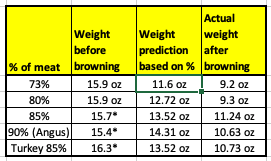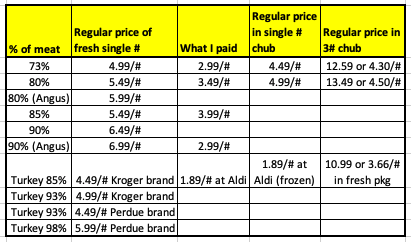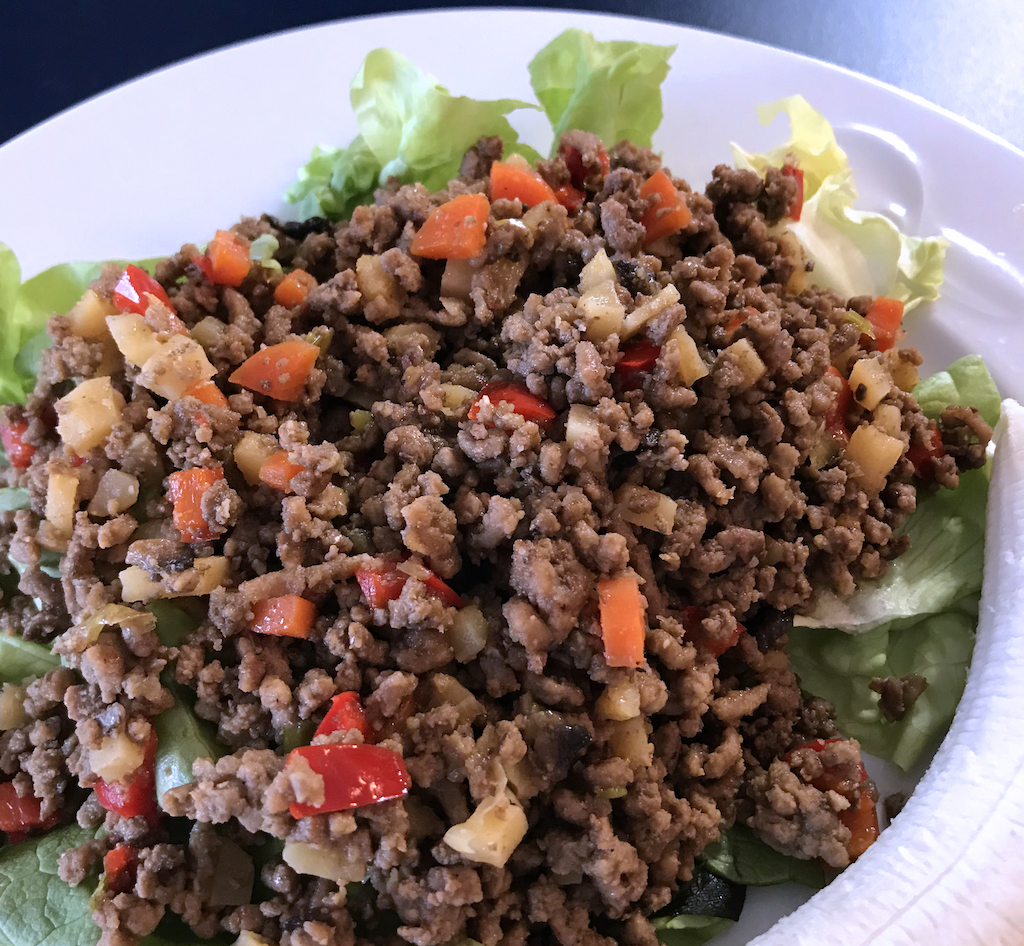Ever wonder how much actual meat is left once you brown ground beef? Yeah, I lay awake at night thinking about things like these…I’m a cost-efficiency nerd. I figured out how to compare the cost of meat off and on the bone for chicken (check that out here), so it’s only natural next I would turn to ground beef. I was born a Texan so beef for chili is a big deal for me. Ground beef is also one of the best meats for one-pot meals! So, here are some nerdy tips for saving on ground beef.
What’s the deal with the percentages?
The meat packaging used to tell us which cut of beef was ground. Now we see percentages. What does all that mean? Well, different cuts have a different percentage of fat…that part that melts when you brown it, and then you spoon it off to discard. The label’s percentage is the amount of actual meat you are supposed to receive in that particular grade of meat.
Standard “ground beef” (73%) can come from any mixture of cuts. This is the lowest grade of ground beef and thus the cheapest.
Next is ground chuck (80%), which is ground from chuck roasts. This is the roast most folks use in their crockpot or Dutch oven with carrots and potatoes for that traditional Southern Sunday dinner. Chuck is known for it’s marbling (“veins” of fat running throughout making it super juicy).
Then we have ground round (85%), taken from round steaks and roasts. Can you see we’re getting ever leaner (more meat content)?
Top of the line is ground sirloin (90%). I’m sure you won’t be surprised it also carries the highest price tag.

The great ground beef test
When I ran my sales list last week, I saw ground sirloin was actually on sale. I also had a digital coupon for $1 off any ground beef product that could be used up to 5 times. This was the perfect time to run this test and not break the bank. I actually paid $13.46 for what would have been $22.96 at normal prices!
I bought one single pound of each grade of meat, then weighed, browned and re-weighed each pound separately. The very first thing I found was just like all other packaging, what it says it weighs and what it weighs is not always the same. Maybe they weigh the meat on it’s styrofoam “plate” but none of the packages I got actually weighed a full 16 ounces (1 pound).
I’ve noted my actual weights for all, but I’ve also adjusted those with * so the comparison is “apples to apples.” (Yes, I used math again. If you wanna know how I did it, just let me know in the comments.) I’ve also included ground turkey as many are using this in an effort to cut fat out of their diets.

I was surprised to find very little difference between the final weights of the lowest two grades AND the top two grades. (My sirloin actually made less than the round. That could have simply been an anomaly…would take significantly more than just one sample to verify that.) My cost savings side says “then why would I pay the higher price???” And of course by now you know I wouldn’t!
Value pack pricing is a wise choice
Actually I seldom buy single-pound, cello-wrapped, fresh store-ground beef because that packaging doesn’t keep the beef from turning brown faster than I can use it. You can’t freeze it in that packaging either…or you’ll end up with ice crystals and freezer burn…yuck!
I buy my ground beef in 3# or 5# “chubs” – the tubes that looks like giant sausages in opaque plastic. You can’t see through it…the light and oxygen can’t get in there as quickly either. You can freeze it this way but of course defrosting something this large takes a significant amount of time. I either brown it one pound at a time or freeze it in single pounds. I vacuum seal each pound pressed flat so they stack easily and defrost quicker because they are thinner.
These chubs often have better sales. Even the single pounders are less expensive than buying the freshly ground one pound at a time. Check it out…

If you’re freaky about using an exact pound rather than eyeballing it like I do, your kitchen scale will help here. Put some sort of dish on the scale BEFORE turning it on so you are truly just weighing the meat. You’ll avoid the messy cleanup of putting the meat right on the scale.
3 steps for saving on ground beef
- Aim for 80% in the 3# chub as it seems to be the best actual meat cost/ounce overall once browned.
- Check for digital coupons. I frequently find “$1 off any package of ground beef” coupons at the Kroger/Ralph’s chains.
- If you use ground beef every week, make sure you stock up when it’s the best price!!! (Your freezer and your vacuum sealer are your friends here!)
And a bonus sales story for you…keep your eyes peeled in the store. One week when beef prices were their highest, I needed beef but found no sales and no ground beef either. I looked at the price tag and walked away. I wouldn’t have bought it for that price even if they had it. I couldn’t afford to.
Apparently, I wasn’t alone in this. Right around the corner, there were piles of 3# chubs of ground beef they hadn’t sold at that horrible price. These were now all marked half off!!! I rewarded this good price with my dollar votes by buying 5 chubs!
Bottom line…

I almost never pay more than $1.99 for ground beef (or turkey) simply because I don’t have to. If I only used 2# of 73% each week paying $1.99/# instead of full price, that’s a savings of $312 per year! You can enjoy these savings on ground beef, too. Just think ahead and watch for sales or coupons!
Got a different strategy for savings on ground beef? Please share in the comments below. We can all learn from each other’s experience.

